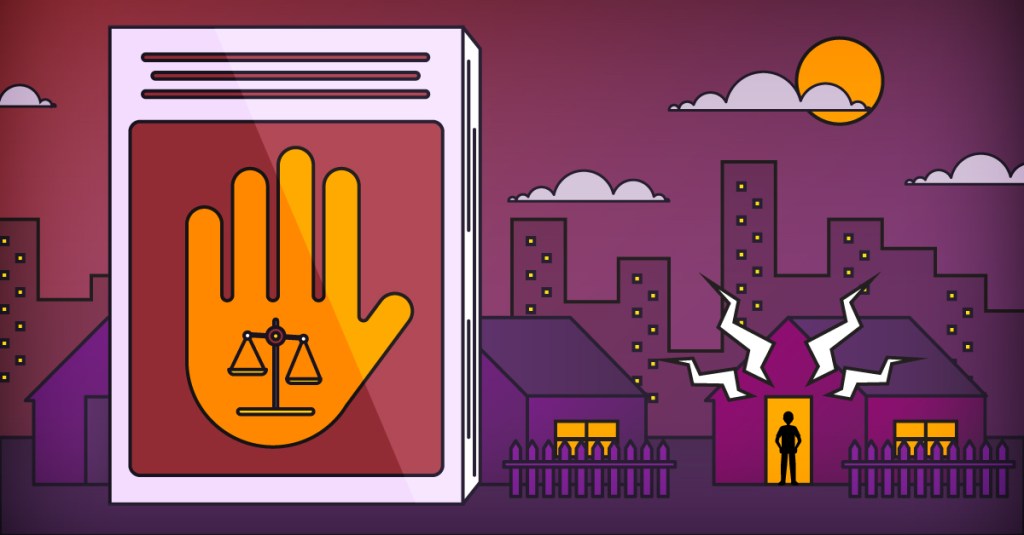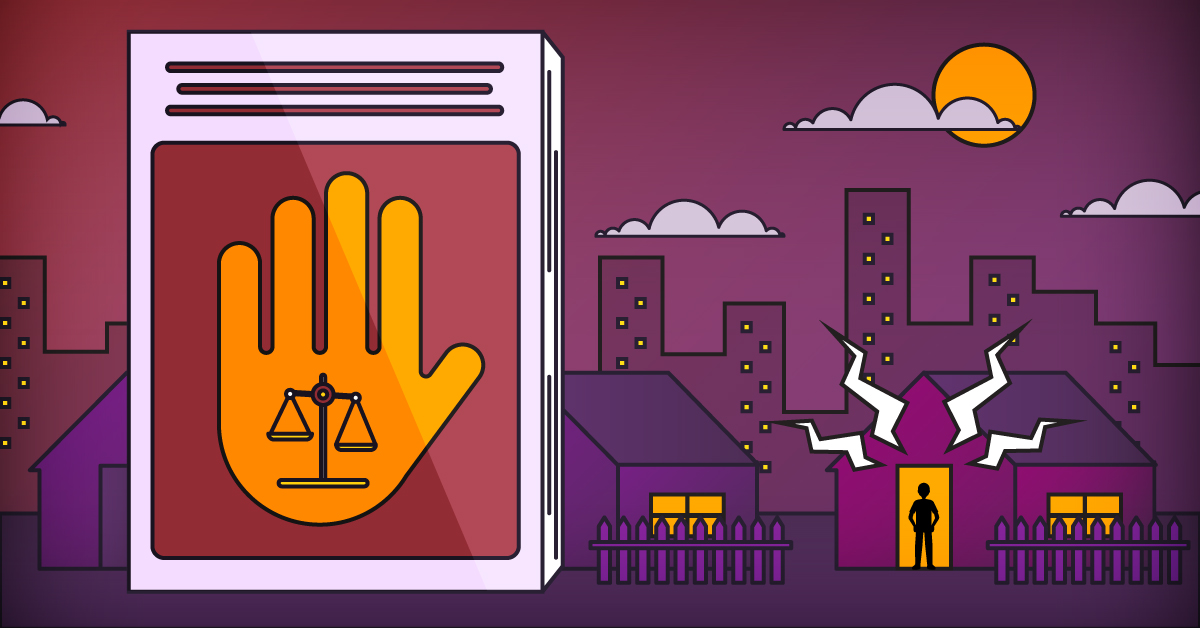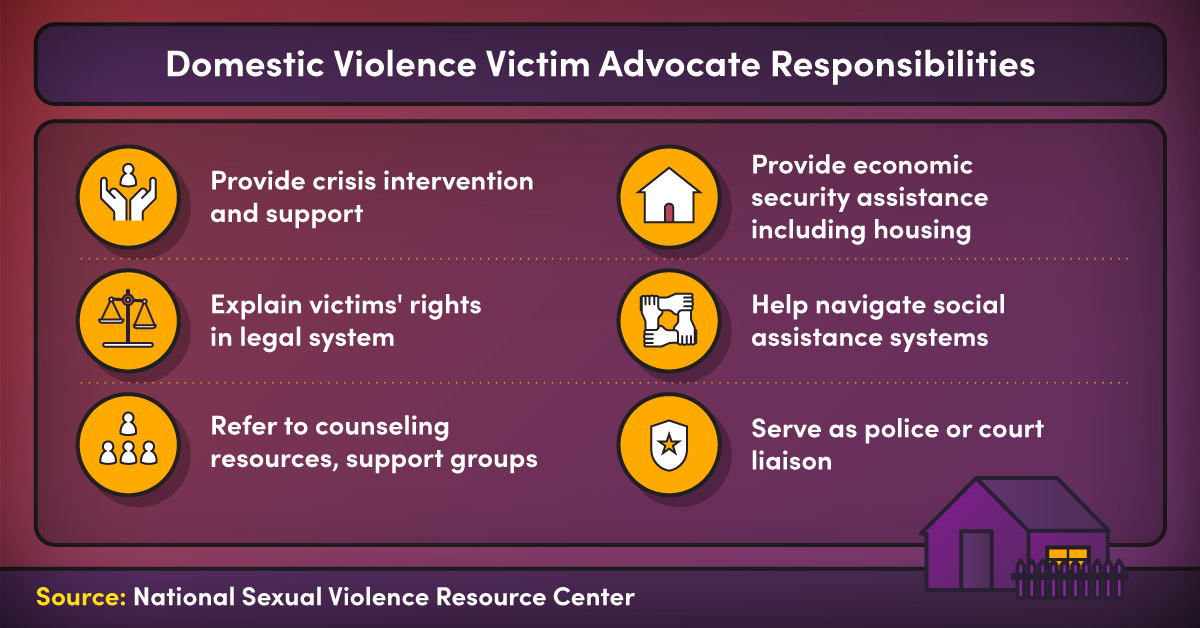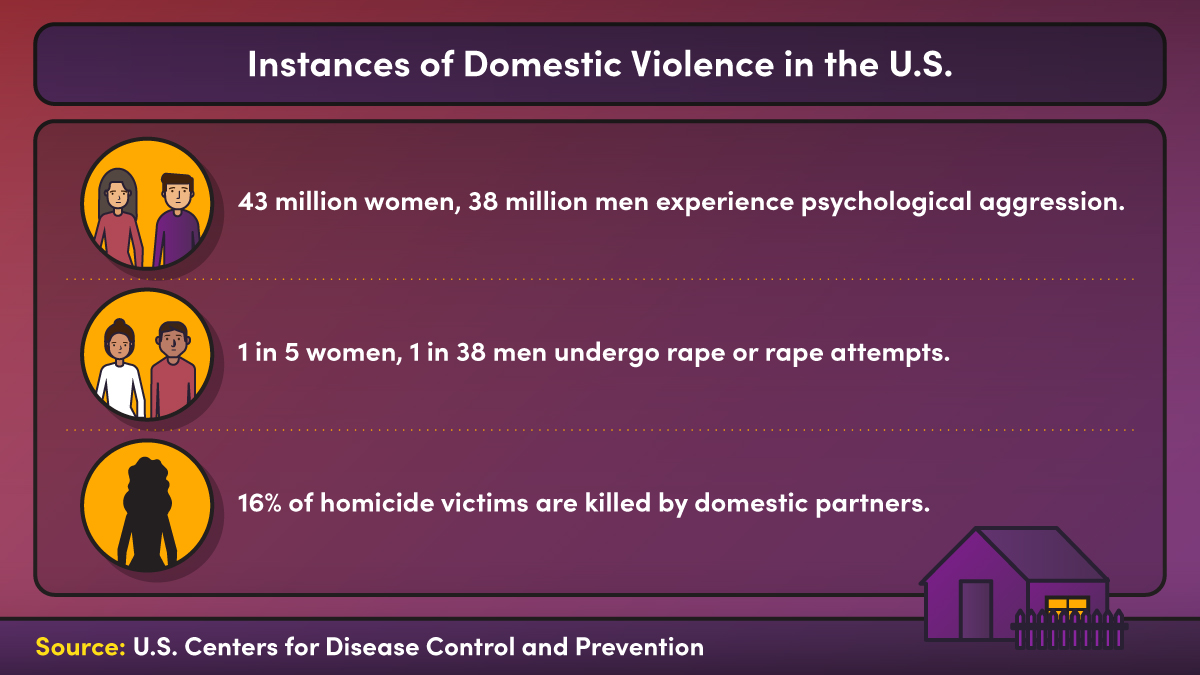Victim Advocacy: Guide to Supporting Survivors of Domestic Violence

Tables of Contents

Victims of domestic violence need access to lifesaving information and emotional support to navigate the legal system, seek justice, and heal. That’s why domestic violence victim advocates are a vital resource. These professional advocates help victims receive the resources and assistance they need to cope and move forward as survivors.
Victim advocacy is a rewarding, complex profession, which requires the development of core interpersonal skills and crisis training experience. Read on to learn more about what victim advocacy entails and how to build a career as a domestic violence victim advocate.
What Is a Domestic Violence Victim Advocate?
A domestic violence victim advocate is a professional who provides vital support to victims of domestic violence. Domestic violence includes physical, emotional, sexual, or psychological abuse inflicted by a spouse, intimate partner, or cohabitant. The domestic violence victim advocate may provide access to:
- Counseling resources and support groups
- Information about legal rights
- Medical care for physical and psychological recovery
- Economic and job assistance
- Safe and accessible housing
- Emotional and legal support in court
- Help with compensation applications
- Assistance communicating with lawyers, family, and employers
Domestic violence victim advocates may be on call to provide support as needed and help victims make crucial decisions in the legal and recovery process.

Roles of Victim Advocates
Victim advocates can serve a range of roles in different work settings. Various types of victim advocacy roles include the following:
- Community advocates. These advocates work for a shelter, social work agency, nonprofit organization, or other community help service.
- Crisis intervention advocates. These advocates may work for sexual assault crisis centers or hotlines, providing on-call services and support to victims 24/7.
- Campus advocates. These advocates work for colleges and universities to help students and staff who are victims of violence or abuse. They may help victims access on-campus support groups and health services.
- Hospital advocates. These advocates work in hospitals to help safely and sensitively treat and provide resources to patients.
- Law enforcement advocates. These advocates may work in police stations, probation offices, parole departments, or prisons to assist victims.
- Court advocates. These advocates may work in lawyers’ offices or local, state, and federal courts to accompany and guide victims throughout the legal process. They may help victims understand their rights, press charges, write impact statements, testify in court, and seek compensation. They may also work in different types of court systems, such as family, military, or juvenile court.
- Public advocates. These advocates provide general public awareness information on victims’ issues and promote victims’ rights in local, state, and federal lawmaking sessions.
Victim advocate roles are also commonly separated into these two categories:
Community advocates
Community advocates work with victims regardless of whether those victims have reported a crime. Victims may find them through shelters, hotlines, or nonprofit organizations. Community advocates’ only job is to help the victim through the process of recovery and keep all information confidential.
System-based advocates
System-based advocates work with victims who are navigating the criminal justice system. They may be stationed in police departments or law offices. Their job is to help victims understand their legal rights and case statuses, and they’re usually obligated to share necessary information with their agency or office.
Why Do We Need Victim Advocates?
Victims of domestic violence need to feel safe and heard. After experiencing abuse, they may endure trauma that will have short- and long-term effects on their physical and mental health. Victim advocates step in to be trusted confidants and resources for those in need who may not have anywhere else to turn.
As reported by the Battered Women’s Justice Project, a study in the mid-1980s revealed that women who had worked with advocates for two weeks after leaving a shelter experienced less violence and depression, and greater access to resources and emotional support than those who hadn’t worked with advocates. A more recent study, from 2013, found that proactive outreach from advocates to victims resulted in increased participation in the criminal justice process and greater benefits for the victims.
Along with providing vital emotional support and medical care, advocates also help victims access important legal information and assistance, so they can safely and productively take the next steps to rebuild their lives. Criminal justice systems, hospitals, and police stations can be confusing and difficult to navigate, especially for people who are recovering from violence and abuse. Victim advocates are there to accompany victims to meetings, appointments, interviews, and court dates if needed.
Types of Domestic Violence
Domestic violence isn’t just physical; it can take many different forms, be difficult to detect and recover from, and evolve over the course of a domestic relationship. Common types of domestic violence include the following:
- Physical abuse. This involves bodily harm, such as hitting, punching, kicking, strangling, and harming with weapons. Physical abusers may also restrain, trap, or stalk victims, making them feel physically unsafe and threatened.
- Sexual abuse. This includes rape, sexual assault, and using sex as a weapon or punishment.
- Emotional abuse. This could involve using words, threats, or forms of neglect to make someone feel lesser than or unvalued.
- Psychological abuse. This happens when abusers cause the victims to question their sanity and experience a breakdown of their mental well-being.
- Financial abuse. This may involve fully controlling a household budget without consent, taking over someone’s bank account, accruing debt in the victim’s name, and not letting the victims have any power over their own finances.
It’s important to remember that domestic violence often doesn’t occur just once. Abusers often establish patterns of abuse, which can emerge at any stage of a relationship and become more severe over time. Abusers may also use many different types of violence, such as the ones listed above, to establish control and harm their victims.
Who Is Involved in Domestic Violence?
Victims of domestic violence can be any age, gender, and relation. Perpetrators of domestic violence can be partners, spouses, parents, guardians, roommates, or other family members or cohabitants. Abuse can also impact witnesses and other family members or close relations. Children of parents with an abusive relationship, for example, may experience emotional or mental health difficulties as a result of living in an abusive household.
As the Office for Victims of Crime reported, it may be difficult for others to identify abusers because they’re often not violent in other relationships. Abusers also deny accusations of abuse or shift the blame to the victim.
Warning Signs of Domestic Violence
Abusers may exhibit certain behaviors or characteristics that can contribute to or indicate abuse. Warning signs of domestic violence include the following:
- Exhibiting possessive, jealous, and controlling behavior
- Isolating victim from other relationships or support systems
- Blaming others for their own problems
- Being cruel to children or animals
- Demonstrating explosive and emotionally irrational behavior
Factors such as abusive family background, history of felony or misdemeanor crimes, drug and alcohol abuse, and mental illness can also contribute to abusive behavior, though they’re not excuses for it or often the sole reasons behind it.

Domestic Violence Facts
Domestic violence facts can help victims and advocates better understand the impact of domestic violence on individuals and their relationships. They can also provide insight into how to detect, prevent, and heal from domestic violence.
Consider these domestic violence facts when researching this field and career:
- One in 4 women and nearly 1 in 10 men have experienced intimate partner violence (physical or sexual violence or stalking), according to the U.S. Centers for Disease Control and Prevention (CDC).
- Over 43 million women and 38 million men have reported experiencing psychological aggression by an intimate partner, according to the CDC. Survivors are also at higher risk for engaging in unhealthy behaviors, such as alcohol and drug abuse.
- Domestic violence can cost victims hundreds of thousands of dollars in medical services, criminal justice costs, and lost work, according to the CDC.
- Intimate partner violence can lead to other negative outcomes, such as mental health problems and conditions that affect the heart, digestive, reproductive, and nervous systems, according to the CDC.
- More than 20,000 phone calls are made to domestic violence hotlines across the U.S. each day, according to the National Coalition Against Domestic Violence (NCADV).
- Only 34% of intimate partner violence victims receive medical services for their injuries, according to the NCADV.
- Domestic violence occurs more often among women in low-income households, according to Doorways for Women and Families.
- Black women have an increased chance (35%) over white women to experience domestic violence, according to Doorways for Women and Families.
- LGBTQ+ and nonbinary identifiers are more likely to experience abuse; transgender women experiencing intimate partner violence are almost 2.5 times more likely to experience sexual abuse, according to Doorways for Women and Families.
- In domestic violence disputes, the presence of a gun increases homicide risk for women by 500%, according to the National Domestic Violence Hotline (16% of homicide victims are killed by domestic partners).
Where to Find Victim Advocate Training
Victim advocacy is a complex, emotionally demanding career. That’s why it’s so important for prospective professionals in this role to complete victim advocacy training and obtain the knowledge and skills they need to build successful careers.
Future advocates can complete victim advocate training by working with the following types of organizations:
- Federal advocacy organizations, such as the National Domestic Violence Hotline
- National nonprofits promoting advocacy, such as:
- State-run organizations, such as family violence prevention centers
- State-level advocacy nonprofits, such as the Missouri Coalition Against Domestic and Sexual Violence, which outlines a comprehensive training program on its website
Domestic violence victim advocates can also enter degree programs in social services, psychology, or criminal justice-related fields, such as forensic psychology, to gain relevant knowledge for their field.
This educational experience can further help advocates pursue advanced certifications through organizations such as the National Organization for Victim Assistance (NOVA).
The Future of Victim Advocacy
Advocates play a crucial role in helping victims of domestic violence heal and take the next steps in their lives. They can speak for advocates who can’t find their voice, and stand by them as they navigate difficult situations and justice systems.
According to the U.S. Bureau of Labor Statistics, careers in psychology, such as domestic violence victim advocates, are expected to grow by 14% from 2018 to 2018 as demand for services in hospitals, mental health centers, social service organizations, and schools increases. Advocates can be there to help victims and survivors of violence receive the resources and support they need to recover and heal.

